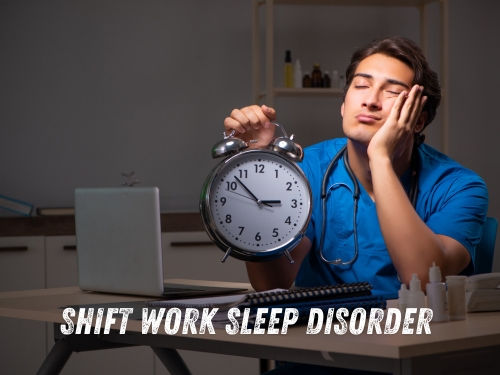What Is Shift Work Sleep Disorder?
Shift Work Sleep Disorder (SWSD) is a condition that affects individuals working non-traditional hours, such as night shifts, rotating shifts, or early morning shifts. It disrupts the body’s circadian rhythm, leading to insomnia, excessive sleepiness, and long-term health issues.
🔹 Did you know? Around 10% of shift workers experience SWSD, making it a significant occupational health concern.
Symptoms of Shift Work Sleep Disorder
SWSD can present as insomnia, daytime sleepiness, or both. Common symptoms include:
✅ Difficulty falling or staying asleep during daytime sleep periods
✅ Sleeping less than 6.5 hours in 24 hours
✅ Excessive sleepiness at work, leading to reduced alertness
✅ Mood disturbances, irritability, or depression
✅ Dependence on caffeine or stimulants to stay awake
✅ High Epworth Sleepiness Scale score (>10)
Who Is at Risk?
👷♂️ Night shift workers
👩⚕️ Rotating shift employees (e.g., healthcare, security, transportation)
🚛 Long-haul truck drivers
✈ Flight attendants & pilots
🏭 Factory workers with extended work hours
If these symptoms persist for more than 3 months and interfere with work and daily life, professional intervention may be needed.
Causes of Shift Work Sleep Disorder
🔸 Disrupted Circadian Rhythm – The body’s internal clock misaligns with work schedules.
🔸 Inconsistent Sleep Schedule – Frequent changes in shifts prevent proper adaptation.
🔸 Light Exposure at the Wrong Time – Exposure to bright light at night affects melatonin production, keeping you awake.
🔸 Lack of Sleep Hygiene – Sleeping in a noisy or bright environment worsens symptoms.
💡 Fun Fact: The body is naturally wired to sleep at night, making night shift adaptation very challenging.
How Is SWSD Diagnosed?
Key Questions to Ask Yourself:
❓ Do you feel excessively sleepy during work hours?
❓ Does your sleep improve on days off?
❓ Do you struggle to sleep during the day after a night shift?
❓ Have you tried adjusting your sleep schedule?
Medical Diagnosis:
🔹 Sleep Diary – Tracking your sleep for at least 2 weeks can reveal irregularities.
🔹 Actigraphy Monitoring – A wearable sleep tracker (like an Actiwatch) measures sleep-wake cycles.
🔹 Epworth Sleepiness Scale – A score greater than 10 suggests excessive sleepiness.
🔹 Polysomnography (Sleep Study) – Conducted if another sleep disorder (e.g., sleep apnea) is suspected.
Best Treatment Strategies for Shift Work Sleep Disorder
✅ 1. Sleep Hygiene & Lifestyle Adjustments
✔ Keep a consistent sleep schedule, even on days off
✔ Use blackout curtains & eye masks to improve daytime sleep
✔ Keep your room cool, quiet, and dark
✔ Limit caffeine, alcohol, and nicotine before bedtime
✔ Take short naps (20-30 minutes) before work to stay alert
✅ 2. Light Therapy 🌞
- Morning/Night Shift Workers: Use bright light therapy during work hours to boost alertness.
- Post-Shift: Avoid exposure to blue light (phones, tablets) to help melatonin production.
- Use Sunglasses when leaving work in the morning to prevent your body from waking up.
✅ 3. Melatonin Supplements 🌙
- Taking 1-3 mg of melatonin 1-2 hours before sleep can help regulate your body clock.
- Best for night shift workers struggling with daytime sleep.
✅ 4. Caffeine & Naps ☕
- Strategic caffeine use (before a shift, not too close to bedtime) can improve alertness.
- Short power naps (20-30 minutes) before or during shifts can prevent excessive sleepiness.
✅ 5. Medications (As a Last Resort) 💊
If lifestyle changes fail, medications may be considered under medical supervision:
💊 Modafinil (Provigil) – A wakefulness-promoting agent for severe sleepiness
💊 Armodafinil (Nuvigil) – Similar to Modafinil, used for alertness during shifts
💊 Hypnotic Sleep Aids – Only recommended for short-term use
⚠️ Warning: Medications should only be used under a doctor’s supervision to avoid dependency.
Long-Term Health Risks of Untreated SWSD
If left untreated, SWSD increases the risk of:
🚨 Heart disease and high blood pressure
🚨 Obesity and metabolic disorders
🚨 Diabetes due to poor glucose regulation
🚨 Depression & anxiety
🚨 Workplace accidents & errors
🚗 Drowsy Driving Alert! Shift workers are at a higher risk of car accidents due to sleep deprivation. Always take precautions when driving home after a night shift.
When to See a Sleep Specialist?
📍 If excessive sleepiness affects work performance & safety
📍 If insomnia or sleep disturbances last more than 3 months
📍 If lifestyle changes & light therapy do not improve symptoms
A Sleep Specialist can recommend customized treatments, including chronotherapy, medication, and advanced sleep studies.
Final Thoughts
Shift Work Sleep Disorder (SWSD) is a serious but manageable condition. By prioritizing sleep hygiene, strategic light exposure, and proper scheduling, shift workers can minimize symptoms and improve overall health.
If you suspect SWSD, take action today to optimize your sleep and work performance!
Helpful Resources
📌 Sleep Health Foundation: www.sleephealthfoundation.org.au
📌 Sleep Foundation: www.sleepfoundation.org
📌 Australian Sleep Association: www.sleep.org.au
📌 Sleep Diary Template: Download Here
About Us
At RSDC we have a particular interest in quick approach and triaging patients with suspected lung malignancy, management of pleural diseases, sleep disorders of obstructive sleep apnoea and other more complex sleep disorders, airways disease including asthma and COPD.
We use a comprehensive approach to interstitial lung disease in addition to occupational and environmental lung disease.

